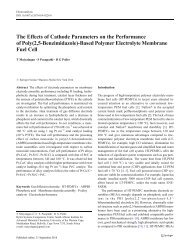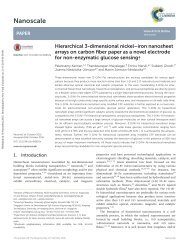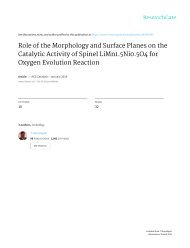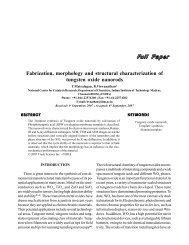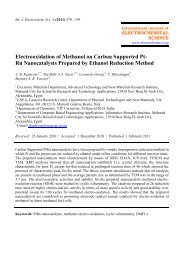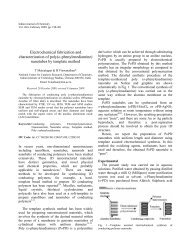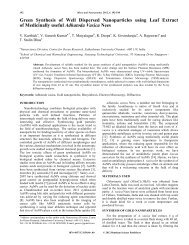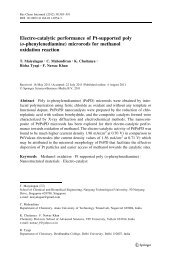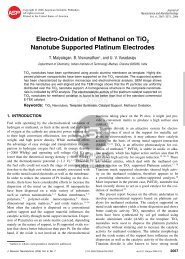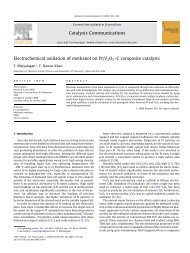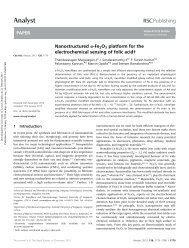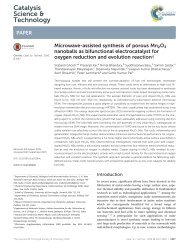2013 Nano Energy
Create successful ePaper yourself
Turn your PDF publications into a flip-book with our unique Google optimized e-Paper software.
See discussions, stats, and author profiles for this publication at: http://www.researchgate.net/publication/256605413<br />
One-pot synthesis of chain-like palladium<br />
nanocubes and their enhanced electrocatalytic<br />
activity for fuel-cell applications<br />
ARTICLE in NANO ENERGY · JULY <strong>2013</strong><br />
Impact Factor: 10.21 · DOI: 10.1016/j.nanoen.<strong>2013</strong>.08.001<br />
DOWNLOADS<br />
225<br />
VIEWS<br />
151<br />
3 AUTHORS, INCLUDING:<br />
Palanisamy Kannan<br />
Nanyang Technological University<br />
32 PUBLICATIONS 335 CITATIONS<br />
T Maiyalagan<br />
Nanyang Technological University<br />
89 PUBLICATIONS 1,094 CITATIONS<br />
SEE PROFILE<br />
SEE PROFILE<br />
Available from: T Maiyalagan<br />
Retrieved on: 28 July 2015
<strong>Nano</strong> <strong>Energy</strong> (<strong>2013</strong>) 2, 677–687<br />
Available online at www.sciencedirect.com<br />
journal homepage: www.elsevier.com/locate/nanoenergy<br />
RAPID COMMUNICATION<br />
One-pot synthesis of chain-like palladium<br />
nanocubes and their enhanced<br />
electrocatalytic activity for fuel-cell<br />
applications<br />
Palanisamy Kannan a,n , Thandavarayan Maiyalagan b,nn ,<br />
Marcin Opallo a<br />
a Institute of Physical Chemistry, Polish Academy of Sciences, 44/52 ul. Kasprzaka, 01-224 Warszawa, Poland<br />
b Materials Science and Engineering Program, The University of Texas at Austin, Austin, TX, USA<br />
Received 7 May <strong>2013</strong>; received in revised form 10 August <strong>2013</strong>; accepted 11 August <strong>2013</strong><br />
Available online 23 August <strong>2013</strong><br />
KEYWORDS<br />
Chain-like<br />
nanoparticles;<br />
Cubic shape;<br />
Formic acid;<br />
Methanol and ethanol<br />
Abstract<br />
A simple approach has been developed for the synthesis of anisotropic cubic chain-like Pd nanostructures<br />
in an aqueous medium. The cubic chain-like Pd nanostructures show better performance<br />
toward oxidation of formic acid and methanol. The cubic chain-like Pd nanostructures show 11.5<br />
times more activity on the basis of an equivalent noble metal mass for the formic acid and methanol<br />
than the spherical shaped Pd nanoparticles and commercial Pd/C catalysts. Further, the superior<br />
electrocatalytic performance of the present anisotropic cubic chain-like Pd nanostructures toward<br />
the oxidation of alcohols makes them excellent candidates as high performance multipurpose<br />
catalysts for direct formic acid fuel cells (DFAFC), direct methanol fuel cells (DMFC), direct ethanol<br />
fuel cells (DEFC), respectively.<br />
& <strong>2013</strong> Elsevier Ltd. All rights reserved.<br />
Introduction<br />
Controlling the morphology of noble metal nanocrystals has<br />
been one of the most recent and attractive research topics<br />
n Corresponding author. Tel.: +48 223 433 375;<br />
fax: +48 223 433 333.<br />
nn Corresponding author. Tel.: +1 512 772 3084<br />
E-mail addresses: ktpkannan@gmail.com (P. Kannan),<br />
maiyalagan@gmail.com (T. Maiyalagan).<br />
for the past few decades, especially in the field of catalysis,<br />
because the catalytic activity and stability of catalysts<br />
are strongly correlated with the size and shape of the nanocrystals<br />
in a variety of chemical reactions [1–3]. Ithasbeen<br />
demonstrated that the intrinsic properties of nanostructured<br />
material can be dramatically enhanced by shape and<br />
structural variation [4–6]. The one dimensional metal nanostructures<br />
like nanowires, nanobelts, and nanotubes have<br />
attracted significant interest due to their exotic technological<br />
applications [7–10]. The surface roughness and inherent high<br />
2211-2855/$ - see front matter & <strong>2013</strong> Elsevier Ltd. All rights reserved.<br />
http://dx.doi.org/10.1016/j.nanoen.<strong>2013</strong>.08.001
678<br />
index facets of anisotropic metal nanoparticles stimulate<br />
impressive applications in electro-catalysis, sensors, SERS<br />
and many more [11–15]. At present, Pt is still the most<br />
commonly used electrocatalytic material for fuel cells in<br />
terms of both activity and stability. However, the high<br />
cost of Pt is one of the most important barriers that<br />
limits the large-scale commercialization of fuel cells [16].<br />
Therefore, economical and effective alternative catalysts are<br />
required.<br />
Among the metal based catalysts studied to date, Palladium<br />
(Pd) is considerably less expensive than Pt, and Pd<br />
has been focusing on recent research as an attractive and<br />
alternative catalysts nanomaterial for a wide range of applications<br />
in catalysis, hydrogen storage and biosensing, reduction of<br />
automobile pollutants and so forth [17–20]. It has been found<br />
that upon appropriate modification of their surface atomic<br />
structure, Pd-based nanomaterials can become promising electrocatalysts<br />
by simultaneously decreasing the material cost and<br />
enhancing the performance [20,21]. Recently, Pd nanoparticles<br />
have been accepted as a better alternative material for<br />
polymer electrolyte membrane fuel cells towards catalytic<br />
oxidation of formic acid as well as oxygen reduction in a<br />
proton-exchange membrane (PEM) fuel cell [22,23]. Furthermore,<br />
Pd nanoparticles have been chosen as the best alternative<br />
material for solving many industrial process problems<br />
and demand the exploration of a new synthetic approach for<br />
production of well-defined shapes and structures. Attempts<br />
have been made to develop anisotropic Pd nanostructures<br />
mainly using surfactants and polymers or high temperature<br />
reactions in organic medium [24–31]. Although, these methods<br />
were successful in producing well-defined Pd nanostructures,<br />
the strong adsorption of these protecting agents resulted in a<br />
decrease of catalytic activity [22]. Nevertheless the aqueous<br />
medium based synthesis of metal nanoparticles is more promising<br />
from an environmental standpoint, adding an advantage<br />
over the use of toxic organic solvents [32–34]. Moreover these<br />
protocols are limited to producing nanoparticles with a smooth<br />
surface morphology. However, it has been observed that the<br />
interesting nanoarchitectures with high surface roughness and<br />
surface steps can contribute to the increased accessibility of<br />
reactant species and are more attractive for enhancing catalytic<br />
application [35]. Therefore, it is highly desirable to explore<br />
a facile approach to produce nanocatalysts with high surface<br />
areas and high degree of structural anisotropy for improved<br />
performance in technological applications.<br />
Herein, we explore a new approach for the synthesis of<br />
chain-like Pd (branches in a tree) nanostructures (PdCNs)<br />
with a cubic morphology in an aqueous medium. Here<br />
we use the neurotransmitter 5-hydroxytryptamine (HT) to<br />
address the environment-friendly and green perspectives. A<br />
notorious problem in the shape-controlled synthesis of<br />
metal nanoparticles is the shape heterogeneity of the<br />
synthesized product. This report clearly demonstrates the<br />
formation of uniform PdCNs with a unique morphology. To<br />
the best of our knowledge, this is the first report that<br />
describes rapid eco-friendly synthesis of cubic chain-like Pd<br />
nanostructures without any template, polymer, surfactant<br />
or without any heat treatment procedures. The cyclic<br />
voltammetry and chronoamperometry are employed to<br />
investigate the morpho-dependent electrocatalytic activity<br />
of these chain-like cubic Pd nanostructures toward the<br />
oxidations of formic acid, methanol and ethanol.<br />
Experimental section<br />
Materials<br />
PdCl 2 and 5-hydroxytryptamine were obtained from Sigma-<br />
Aldrich Chemical Company. The phosphate buffer solution<br />
(PBS; pH=7.2) was prepared using Na 2 HPO 4 and NaH 2 PO 4 .<br />
Double distilled water was used to prepare the solutions in<br />
this investigation. All other chemicals used in this investigation<br />
were of analytical grade. All the solutions were prepared with<br />
deionised water (18 mΩ) obtained from Millipore system.<br />
Synthesis of cubic chain-like Pd nanostructures<br />
Glasswares used for synthesis were well cleaned with freshly<br />
prepared aqua regia (3:1 HCl and HNO 3 ), then rinsed<br />
thoroughly with water and dried prior to use (Caution! aqua<br />
regia is a powerful oxidizing agent and it should be handled<br />
with extreme care). In a typical synthesis, 10 ml aqueous<br />
solution of PdCl 2 (0.1 mM) was taken in a beaker and then<br />
0.1 ml of 5-hydroxytryptamine (5-HT) (10 mM) was rapidly<br />
injected into the solution, allowed for 30 min in static state.<br />
The resulting nanocolloid was stored at 4 1C for further use.<br />
Characterization<br />
The morphologies of the cubic chain-like, dendrites and<br />
fractal Pd nanostructures were characterized by a field<br />
emission-scanning electron microscopy (FE-SEM JEOL JSM-<br />
6301F). The specimens were prepared by dropping 3 μl of<br />
colloidal solution onto silicon wafer substrate. The crystallographic<br />
information of the prepared Pd chain-like nanostructures<br />
were studied by the powder X-ray diffraction<br />
technique (XRD, Shimadzu XRD-6000, Ni filtered CuKα<br />
(λ=1.54 Å) radiation operating at 30 kV/40 mA).<br />
Electrochemical measurements<br />
Electrochemical measurements were performed using two<br />
compartment three-electrode cell with a glassy carbon<br />
working electrode (geometric area=0.07 cm 2 ), a Pt wire<br />
auxiliary electrode and Ag/AgCl (3 M KCl) as reference<br />
electrode. Cyclic voltammograms were recorded using a<br />
computer controlled CHI643B electrochemical analyzer. All<br />
the electrochemical experiments are carried out in an argon<br />
atmosphere. The 3 μl of as-synthesized chain-like nanostructures<br />
are dispersed over glassy carbon electrode with<br />
nafion and dried prior to electrochemical experiments.<br />
Results and discussion<br />
P. Kannan et al.<br />
The cubic chain-like Pd nanostructures have been characterized<br />
to establish their nanostructure and mechanism of<br />
shape evolution. Figure 1 shows the FE-SEM images obtained<br />
for the nanoparticle synthesized using 5-HT. The FE-SEM<br />
image shows that Pd nanoparticles were cubic morphology<br />
with chain like-structures (branches in a tree; Figure 1a–d).<br />
The cubic chain-like Pd nanocubes have an average size<br />
between 140 160 nm and 140 210 nm. Furthermore, we<br />
examine the stability of cubic chain like-structures PdCNs
One-pot synthesis and enhanced electrocatalytic activity of chain-like palladium nanocubes<br />
679<br />
Figure 1 FE-SEM images of (a) simple branched chain-like cubic Pd nanostructures using 5-HT (0.1 mM), (b) a portion of image “a”,<br />
(c) a portion of image “b” and (d) a portion of image “c”.<br />
prepared at a conc. of 0.1 mM 5-HT, the FE-SEM images were<br />
taken after 1 and 5 h time interval and presented in<br />
Figure 2a–c. From the FE-SEM measurements the density,<br />
length and number of cubic branches per nanochains were<br />
almostsameoverthegrowthperiodupto5h(Figure 2aandb).<br />
These time-dependent features can be ascribed either to the<br />
aggregation of nanoparticles or the growth of anisotropic<br />
nanostructures. The morphology of cubic chain-like Pd nanostructures<br />
remained the same even after 5 h, implying that the<br />
observedfeatureisnotduetotheaggregationofnanoparticles.<br />
The chain-like Pd nanocubes grow up to the size of 80 mm<br />
with more than 25 branches in 5 h (Figure 2d). The observed<br />
results suggest that the cubic chain-like morphology is highly<br />
stablebyvaryingthetimeintervals(both30min,1and5h).To<br />
the best of our knowledge, this is the first report that describes<br />
rapid eco-friendly synthesis of cubic chain-like Pd nanostructures<br />
(branches in a tree) at room temperature without any<br />
heat treatment, template, polymer, or surfactant. The overview<br />
of the mechanism for formation of such a unique shape<br />
can be outlined in Scheme 1 as: (i) in the initial stage of<br />
reaction, Pd 2+ ions are reduced by 5-HT to form nano-sized<br />
small Pd cubic shaped nanoparticles (around 5–10 min), (ii) a<br />
homogeneous nucleation of these cubic nanoparticles forms<br />
small, primary Pd cubic nano-chains by gradual assembly of<br />
these particles that grows into a one-dimensional interconnected<br />
nanostructure and a complete growth of cubic chainlike<br />
nanostructures was observed after 30 min of reaction<br />
(iii) these primary particles undergo nucleation/assemble due<br />
course over time into a 1-D nanostructure and reconstruction of<br />
these small nanocubes into cubic dendritic nanowires [36,37].<br />
We propose that, 5-HT molecule (stabilising/reducing agent)<br />
plays a vital role on selective binding on the surface of<br />
1-D nanostructure and reconstruct the tiny nanocubes into<br />
dendritic-like nanochains. The growth of nanostructured particles<br />
is highly perceptive to the concentration of 5-HT and<br />
precursor, Pd 2+ (Figure 3). Here we demonstrate that cubic<br />
chain-like Pd nanostructures, cubic small dendrites of Pd<br />
nanostructures, cubic big-dendrites of Pd nanostructures and<br />
fractal Pd nanostructures could be selectively prepared by<br />
manipulating and controlling the concentration of 5-HT and<br />
Pd 2+ (Figures 4, 5 and Figure S1). It should be noted here that<br />
this procedure establishes a universal protocol for synthesis of<br />
monodisperse Pd nanostructures with a variety of shapes<br />
without adopting different strategies, reaction conditions, or<br />
injection of foreign reagents. Minor change in the concentrations<br />
of stabilizer and a fixed concentration of precursor or<br />
vice versa results in the formation of different morphologies of<br />
the nanoparticles assembly (Figure 3).<br />
Recently, Willner and co-workers have reported the cataecholamine<br />
neurotransmitters mediated growth of Au nanoparticles<br />
and their quantification by optical method [38]. The<br />
catacholamine neurotransmitters and their metabolites induce<br />
thegrowthofsphericalshapenanoparticles,andtheydonot<br />
induce the formation of any anisotropic nanoparticles [38]. In<br />
the present investigation, we observed cubic Pd nanochains,<br />
cubic nanostructures of big-dendrites, and fractal nanostructures<br />
by the indoleamine neurotransmitter. The formation of<br />
chain-like nanostructured particles is attributed to the oxidation<br />
of 5-HT by PdCl 2 .AsshowninScheme 2, reduction of<br />
PdCl 2 occurs due to the transfer of electrons from HT to the<br />
metal ion, resulting in the formation of Pd 0 . The metallic Pd<br />
then undergoes nucleation and growth with time to form cubic<br />
chain-like Pd nanostructures, cubic nanostructures of dendrites<br />
and fractal nanostructures. It is well documented in the
680<br />
P. Kannan et al.<br />
Figure 2 FE-SEM images of simple branched chain-like cubic Pd nanostructures using 5-HT (0.1 mM) after 1 h (a), 5 h (b) and close<br />
view of image “b”. The image “c” represents the length of the branches in a sample. The image “d” represents maximum length of<br />
chain-like nanocubic particles.<br />
5-HT<br />
Pd cubes<br />
Nucleation<br />
Primary cubic Pd chain-like nanostructure<br />
Reconstruction<br />
Self-assembly<br />
Scheme 1 Schematic presentation showing the formation/<br />
growth process of cubic chain-like Pd nanostructures and<br />
dendritic nanochains.<br />
literature that the oxidation of 5-hydroxyindole generates a<br />
free radical [39–43]. The radical generated by the oxidation of<br />
HT can undergo a chemical reaction in aqueous solution to<br />
yield different products. The reaction of radical strongly<br />
depends on the experimental condition. The hydroxylated<br />
dimers (5,5'-Dihydroxy-4,4'-bitryptamine (DHB)) and tryptamine-4,5-dione<br />
(TAD) (Scheme 2) arethemajorproductsin<br />
neutral and acidic pH. These oxidation products are expected<br />
to adsorb on the surface of the nanoparticles (vide infra) by<br />
different orientations, resulted that different cubic chain-like<br />
Pd nanostructures. In Scheme 2, “a” and “b” representing the<br />
reversible redox reaction, these oxidized products were<br />
expected to adsorb on the surface of the nanoparticles<br />
through amino groups (–NH 2 ), resulted the Pd nanoparticles.<br />
It is expected that the hydrogen bonding between above two<br />
compounds with PdNPs (cellulose type hydrogen bonding),<br />
resulting that chain-like nanostructures.<br />
We suggest that the balance act between the concentration<br />
of precursor and stabilizer determine their shape<br />
evolution process. The effect of Pd 2 + concentration can<br />
be speculated as at high concentration, Pd 2 + ions are<br />
floating around to seed the growth of the Pd nanocubes<br />
and speed up the nucleation to form compact large nanocubes.<br />
On the other hand at lower concentration the Pd 2 +<br />
ions are diluted enough to decrease the seeding and small<br />
cubic chain-like nanostructures were formed. Those small<br />
nanocubes undergo controlled nucleation to form the<br />
dendritic morphology. When the concentration of 5-HT<br />
is increased, Pd nanostructures with a big dendritic and<br />
fractal shaped morphology were obtained. This may be due<br />
to the high concentration of 5-HT (reducing/stabilising<br />
agents) which not only expedites the reduction of Pd 2 + to
One-pot synthesis and enhanced electrocatalytic activity of chain-like palladium nanocubes<br />
681<br />
HT (0.1 mM)<br />
Pd (0.1 mM) in 10 mL<br />
+<br />
5-Hydroxytryptamine (HT)<br />
HT (0.3 mM)<br />
HT (0.5 mM)<br />
HT (0.75 mM)<br />
Figure 3<br />
Pd(II).<br />
FE-SEM measurements of different morphologies of Pd nanoparticles induced at different concentrations of 5-HT and<br />
Figure 4<br />
FE-SEM images of 5-HT-induced (0.3 mM) formation of cubic chain-like small dentries of Pd nanostructures.
682<br />
P. Kannan et al.<br />
Figure 5<br />
FE-SEM images of 5-HT-induced (0.5 mM) formation of cubic chain-like big-dendrites of Pd nanostructures.<br />
Pd 0 , but also controls the nucleation process. Our examination<br />
concludes that the optimal metal precursor concentration<br />
for the preparation of Pd nanoparticles with uniform<br />
distribution of nanocubes was of 0.5 mM. When the concentration<br />
goes up to 0.75 mM, the chain-like cubic nanoparticles<br />
were aggregated. The sufficient numbers of 5-HT<br />
molecules present around the reaction direct the nucleation/assembly<br />
of the reduced primary Pd cubic nanoparticles<br />
in different arrays or unique direction to produce cubic<br />
chain-like Pd dendritic nanostructures, nanostructures of<br />
small, big-dendrites, and multiple chain-like fractal shapes.<br />
So it can be speculated that the concentration of 5-HT not<br />
only stabilizes the nano-sized particles but its structure<br />
plays a vital role in controlling their nucleation or growth<br />
process in a universal pattern to produce cubic chain-like Pd<br />
nanostructures, cubic chain-like dendritic or fractal shapes.<br />
It is well established that using surfactants or polymers with<br />
different functional groups having different binding strategies<br />
such as acids and amines regulate the morphology of<br />
nanopararticles [44]. The formation of different shapes and<br />
morphology is controlled by the faceting tendency of the<br />
stabilizer and the growth kinetics to crystallographic planes<br />
[6,29,30]. We anticipate here that the structure and functional<br />
groups of reducing/stabilizing agents play a vital role<br />
in shape and morphology evolution of nanoparticles.<br />
Our efforts are yet underway to establish the structure–<br />
function relationship of the stabilizer for shape evolution of<br />
Pd nanoparticles using the bi-products of 5-HT (DHB and<br />
TAD). We propose a reasonable explanation towards the<br />
balancing act between the concentration of precursor and<br />
stabilizer for shape evolution of Pd nanostructures in<br />
Schemes 1 and 2.<br />
The X-ray diffraction (XRD) patterns were recorded to<br />
confirm the lattice facets of cubic chain-like Pd nanostructures<br />
as shown in Figure 6. Peaks corresponding to Pd (111),<br />
(200), (220) and (311) were obtained. The relative peak<br />
intensities were compared using the peak area of (111) as a<br />
reference (JCPDS card number: 41-1021). The ratio of the<br />
relative peak intensity of (200) with respect to (111) is<br />
found to be 0.52 versus 0.6 of the standard value. However,<br />
the ratio of the relative peak intensities of high index planes<br />
(220) and (311) are higher than the standard values previously<br />
reported (0.73 versus 0.42) and (0.71 versus 0.55),<br />
respectively [17,45,46]. This observation reveals that the<br />
cubic chain-like Pd nanostructures were abundant in high<br />
index facets. Further, XRD patterns for cubic small dendrites<br />
Pd nanostructures, cubic chain-like big-dendrites Pd nanostructures<br />
and fractal nanostructures of Pd nanostructures<br />
were recorded to confirm their lattice facets (Figure 6 and<br />
Figure S2). For instance, the ratio of the relative peak<br />
intensities of high index planes (220) and (311) is 0.61 versus<br />
0.42 and 0.65 versus 0.55 respectively for cubic small<br />
dendrites Pd nanostructures, which is lower than the values<br />
obtained for cubic chain-like Pd nanostructures (0.73 versus<br />
0.42) and (0.71 versus 0.55). Moreover, the formations of Pd<br />
nanoparticles were also investigated in the presence of<br />
5-hydroxyindoleacetic acid and N-aceltyserotonin, that are<br />
functionally correlated with respect to 5-HT. In similar<br />
conditions, both these structurally different molecules<br />
induce the formation of Pd nanostructures but the morphology<br />
differs (Figure S3). We anticipate here that the<br />
structure and functional groups of reducing/stabilizing<br />
agents affect the shape and morphological evolution of<br />
nanoparticles.
One-pot synthesis and enhanced electrocatalytic activity of chain-like palladium nanocubes<br />
683<br />
OH<br />
Pd 2+<br />
HN<br />
5-hydroxytryptamine<br />
O*<br />
NH 2<br />
-H +<br />
HN<br />
Pd 0<br />
NH 2<br />
HN<br />
OH<br />
N<br />
HO<br />
O<br />
a<br />
N<br />
N<br />
NH2<br />
NH 2<br />
HO<br />
OH<br />
2e -<br />
2e -<br />
2H + b 2H +<br />
O<br />
H<br />
N<br />
O<br />
NH<br />
NH 2<br />
NH 2<br />
PdNPs<br />
HN<br />
NH<br />
N<br />
H<br />
N<br />
N<br />
OH<br />
O<br />
OH<br />
OH<br />
OH<br />
OH<br />
O<br />
N<br />
NH NH<br />
HN PdNPs<br />
NH<br />
HO<br />
HO<br />
NH2<br />
NH 2<br />
N<br />
5,5'-Dihydroxy-4,4'-bitryptamine (DHB)<br />
N<br />
H<br />
tryptamine-4,5-dione (TAD)<br />
‘a’ and ‘b’ represent the reversible redox reaction.<br />
Scheme 2<br />
Mechanism for 5-HT induced formation of Pd nanostructures with different branches with cubic and fractal shapes.<br />
(111)<br />
(111)<br />
Intensity (a.u.)<br />
(200)<br />
(220) (311)<br />
Intensity (a.u.)<br />
(200)<br />
(220)<br />
(311)<br />
20 40 60 80<br />
2 Theta (Degree)<br />
20 40 60 80<br />
2 Theta (Degree)<br />
Figure 6 XRD pattern of as synthesized cubic chain-like Pd nanostructures (a) and cubic chain-like small dendrite of Pd<br />
nanostructures (b).<br />
Pd is well-known to absorb massive quantities of hydrogen<br />
in bulk to form hydrides and therefore has a great<br />
technological potential as a hydrogen storage material [47].<br />
We have carried out cyclic voltammetric studies in acidic<br />
medium to examine the affinity of hydrogen toward all<br />
cubic chain-like Pd nanostructures. Figure 7 shows the<br />
voltammetric behavior of the cubic chain-like Pd nanostructures<br />
modified electrode in 0.5 M HClO 4 at a scan rate<br />
of 50 mVs 1 . The cyclic voltammogram (CVs) obtained for<br />
cubic chain-like Pd nanostructures in 0.5 M HClO 4 shows<br />
sharp distinguished anodic peaks in between 0.25 and<br />
–0.15 V. This broad peak is due to the oxidation of both the<br />
absorbed and adsorbed hydrogen on the cubic chain-like Pd<br />
nanostructures and has been earlier reported for bulk Pd<br />
electrodes [48]. However, the CV for the cubic chain-like Pd<br />
nanostructures coated disk electrode shows two distinct
684<br />
P. Kannan et al.<br />
Current Density (mA/cm 2 )<br />
0.8<br />
0.4<br />
0<br />
0.4<br />
0.8<br />
d<br />
a<br />
Current Density (mA/cm 2 )<br />
0<br />
0.05<br />
a<br />
d<br />
–0.5 0 0.5 1<br />
Potential (V) vs. Ag/AgCl<br />
0.5<br />
Potential (V) vs. Ag/AgCl<br />
Figure 7 (A) CVs of fractal Pd nanostructures (a), cubic Pd big-dendrites (b), cubic chain-like small dendrites of Pd nanostructures<br />
(c) and cubic chain-like Pd branched nanostructures in N 2 -saturated 0.5 M HClO 4 solution at a scan rate of 50 mV s 1 .<br />
voltammetric peaks, one of which is a small shoulder peak<br />
in the negative potential region during the anodic sweep<br />
[48–51]. The first peak at 0.23 V corresponds to the oxidation<br />
of the adsorbed hydrogen (H ad ), while the subsequent<br />
peak at 0.18 V is due to the oxidation of the absorbed<br />
hydrogen (H ab ) on Pd surface [49]. The cathodic peak during<br />
the reverse scan is due to both absorption and adsorption of<br />
hydrogen. It is known from the literature that the two wellresolved<br />
peaks for the oxidation of adsorbed and absorbed<br />
hydrogen in Pd are manifested exclusively in the case of Pd<br />
nanoparticles. This behavior is attributed to the larger<br />
number of surface sites available for adsorption on the<br />
nanoparticle's surface [48–51]. The large anodic peak corresponding<br />
to the desorption of hydrogen in the case of cubic<br />
chain-like Pd nanostructures modified electrode shows its<br />
potential as an excellent hydrogen storage material. The<br />
electroactive surface area of Pd has been measured from<br />
the palladium oxide stripping analysis [48]. The charge<br />
consumed during the reduction of Pd oxides has been<br />
estimated by integrating the area under the reduction<br />
wave. The electric charge of the hydrogen desorption of<br />
cubic chain-like Pd nanochains, small cubic nanostructures<br />
of dendrites, big-dendrites and fractal nanostructures were<br />
measured to be 132.4, 366.2, 509.4, and 784.2 μC (a–d)<br />
respectively. The electrochemically accessible area of cubic<br />
chain-like Pd nanostructures was calculated to be 1.476 cm 2<br />
using the reported value of 424 μC cm 2 . This is a very large<br />
real surface area for the other chain-like Pd nanostructures<br />
such as cubic nanostructures of small dendrites, big-dendrites,<br />
and fractal nanostructures are 0.875 0.554, and<br />
0.253 cm 2 , respectively. This large surface area arises due to<br />
cubic chain-like Pd nanostructures in which the Pd nanocubes<br />
were highly dispersed making a branches-on a tree type of<br />
nanostructure. Since the Pd nanoparticles were directly modified<br />
on the electrode surface, the available effective active<br />
centers were also higher, which makes them an ideal electrocatalytic<br />
nanomaterial.<br />
Inspired by the attractive cubic chain-like structures and<br />
unique morphology of Pd nanostructures, we further proved<br />
these as nanoelectrocatalyst. Very recently Mohanty et al.<br />
observed a dramatic catalytic performance of dendritic noble<br />
metal nanoparticles towards the Suzuki–Miyaura and Heck<br />
coupling reaction [17]. Here we use methanol, ethanol and<br />
formic acid as model molecules for studying the<br />
electrocatalytic performance of cubic chain-like Pd nanostructures.<br />
The electrochemical oxidation of methanol and<br />
formic acid has attracted much attention due to their<br />
potential energy related applications for direct methanol<br />
fuel cells (DMFC) and direct formic acid fuel cells (DFAFC),<br />
respectively. It is generally accepted that noble Pt metal is<br />
the best catalyst for the formic acid oxidation but it suffers<br />
poisoning due to a strong adsorbed CO species generated as<br />
reaction intermediates [52]. A noble Pd-based catalyst was<br />
explored to be efficient and possesses superior performances<br />
for fuel cell applications because it is highly resistant to CO<br />
poisoning [22]. We have examined the electrocatalytic<br />
activity<br />
of<br />
as-synthesized chain-like cubic Pd nanostructures towards<br />
formic acid and methanol oxidation (Figure 8). Well-defined<br />
voltammograms with prominent peaks in the forward and<br />
reverse scans were obtained, respectively. The oxidation<br />
current has been normalized to the electroactive surface<br />
area of the cubic chain-like Pd nanostructures. This surface<br />
area was determined from the coulombic charge reduction of<br />
Pd oxide (vide supra), according to the reported value of<br />
424 mC cm 2 . As shown, the as-synthesized cubic chain-like<br />
Pd nanostructures of different branched morphologies exhibit<br />
different electrocatalytic activities.<br />
The oxidation of formic acid on Pt involves a dual path<br />
mechanism, a dehydrogenation path to the direct formation<br />
of CO 2 and a dissociative adsorption to form poisoning CO<br />
species (a dehydration path) [53–55]. It can be seen that the<br />
formic acid electro-oxidation on these present cubic chainlike<br />
Pd nanostructures shows two anodic peaks in the<br />
forward scan. The onset potential and peak potential on<br />
cubic chain-like Pd nanostructures are 0.15 and 0.13 V,<br />
respectively (Figure 8A, curve b). The first small anodic<br />
peak is attributed to the direct oxidation of formic acid to<br />
CO 2 on the remaining sites unblocked by intermediate<br />
species. At higher potentials, the current further increases<br />
and reaches another peak. The second peak is related to the<br />
oxidation of adsorbed intermediate species (CO), which<br />
releases the free surface sites for the subsequent direct<br />
oxidation of formic acid. In the reverse scan, the current<br />
reaches a high peak located at around 0.02 V, which is<br />
much higher than those in the positive scan, due to the bulk<br />
HCOOH oxidation and the absence of CO poison. However,<br />
with the potential scanning to more negative values, the
One-pot synthesis and enhanced electrocatalytic activity of chain-like palladium nanocubes<br />
685<br />
Current Density (mA/cm 2 )<br />
10.0<br />
8.0<br />
6.0<br />
4.0<br />
2.0<br />
0.0<br />
a<br />
b<br />
c<br />
d<br />
e<br />
f<br />
Current Density (mA/cm 2 )<br />
6.0<br />
5.0<br />
4.0<br />
3.0<br />
2.0<br />
1.0<br />
0.0<br />
-0.1<br />
a<br />
b<br />
c<br />
d<br />
e<br />
f<br />
-0.3 -0.2 -0.1 0 0.1 0.2 0.3<br />
Potential (V) vs. Ag/AgCl<br />
-0.3 -0.2 -0.1 0 0.1 0.2 0.3<br />
Potential (V) vs. Ag/AgCl<br />
Figure 8 Cyclic voltammograms show the oxidation of (A) formic acid (0.25 M) in 0.5 M HClO 4 and (B) methanol (0.25 M) in<br />
0.1 M KOH at (a) bare GC, (b) cubic chain-like Pd nanochains, (c) cubic chain-like Pd nanochains in the absence of both formic acid<br />
and methanol, (d) cubic small dendrites of Pd nanostructures, (e) cubic big-dendrites Pd nanostructures and (f) fractal Pd<br />
nanostructures modified electrodes. Scan rate: 50 mV s 1 .<br />
surface was again poisoned by CO, resulting in the decrease of<br />
the oxidation current [56–59]. The oxidation of formic acid at<br />
cubic chain-like Pd nanostructures is higher than those on<br />
cubic chain-like small dendrites of Pd nanostructures ( 0.10<br />
and 0.16 V), cubic big-dendrites Pd nanostructures ( 0.10 and<br />
0.16 V) and fractal Pd nanostructures ( 0.07 and 0.18 V),<br />
indicating that the formic acid is easier to oxidize on cubic<br />
chain-like Pd nanostructures. The peak current density for<br />
cubic chain-like Pd nanostructures is 760 mA/cm 2 ,whichis<br />
much higher than that for cubic small dendrites of Pd<br />
nanostructures (480 mA), cubic big-dendrites Pd nanostructures<br />
(460 mA) and fractal Pd nanostructures (250 mA).<br />
This should be resulted from its highest ECSA. The specific<br />
surface activities of these catalysts could be obtained from<br />
the normalized peak current density with ECSA to further<br />
investigate the possibility of the enhancement effect of cubic<br />
branched nanostructures on the intrinsic electrocatalytic<br />
activity, which is 10.8, 6.8, 6.5 and 3.5 Am 2 for cubic<br />
chain-like Pd nanostructures, cubic small dendrites of Pd<br />
nanostructures, cubic big-dendrites Pd nanostructures and<br />
fractal Pd nanostructures, respectively. The low onset and<br />
oxidative peak potential value (less positive potential), much<br />
higher specific surface activities of the cubic chain-like Pd<br />
nanostructures catalysts towards formic acid oxidation may be<br />
attributed to the presence of branched (branches in a tree)<br />
morphology. On the other hand, the present Pd nanostructures<br />
also efficiently catalyze the oxidations of methanol (Figure 8B)<br />
and ethanol (Figure S4). We summarized the activity of Pd<br />
nanostructures in terms of oxidation potential and generated<br />
catalytic current-density and these data are provided in<br />
(Table S1). Further, we compared the electrocatalytic performance<br />
of the present branched cubic chain-like nanoparticles<br />
to commercial Pd/C and spherical PdNPs toward the<br />
oxidation of formic acid and methanol (Figures S5 and S6).<br />
The current densities were also normalized to the electroactive<br />
surface area, which were measured from the electric<br />
charge of hydrogen adsorption/desorption on Pd surfaces.<br />
Such normalization allowed the current density to apply<br />
directly for comparison of the catalytic activities of the<br />
different catalysts. The cubic chain-like Pd nanostructures<br />
show Z11.5 (comparison for both cases) times more activity<br />
on the basis of an equivalent noble metal mass for the formic<br />
acid and methanol than the spherical shaped PdNPs and<br />
Current Density (mA/cm 2 )<br />
8.0<br />
7.0<br />
6.0<br />
5.0<br />
4.0<br />
3.0<br />
2.0<br />
1.0<br />
0<br />
0 2000 4000 6000<br />
Time (Sec)<br />
Figure 9 Polarization current vs. time plots of branched cubic<br />
chain-like Pd nanostructures (a), cubic small dendrites of Pd<br />
nanostructures (b), cubic big-dendrites of Pd nanostructures<br />
(c) and fractal Pd nanostructures (d) modified electrodes measured<br />
in formic acid (0.25 M) in 0.5 M HClO 4 solution.<br />
commercial Pd/C catalysts. This may be attributed to the<br />
high degree of structural anisotropy of cubic chain-like Pd<br />
nanostructures and branched tree-like morphology contributing<br />
to their superior electrocatalytic activities. The rich<br />
branched sharp edges and corner atoms of tree-like structures<br />
were highly preferred for improving the catalytic<br />
activity [60]. The long-term stability of these catalysts was<br />
evaluated by the chronoamperometry method and also the<br />
current decay, which is associated with the poisoning of<br />
intermediate species on the nanoparticles determining the<br />
fate of its practical application. The chronoamperometry<br />
profile is sufficiently stable for cubic chain-like Pd nanostructures<br />
and cubic nanostructures of dendrites morphologies.<br />
The chronoamperometric stabilities of cubic chain-like<br />
Pd nanostructures, cubic nanostructures of small dendrites,<br />
cubic big-dendrites and fractal nanostructures were investigated<br />
using towards formic acid oxidation and as shown in<br />
Figure 9. The polarization current for the formic acid<br />
oxidation reaction on these three supported Pd catalysts<br />
shows a significant decay initially and reaches a stable value<br />
after polarization at 0.20 V for 400–600 s. The current decay<br />
for the formic acid oxidation reaction indicates the slow<br />
deactivation of the nanostructued Pd-based electrocatalysts<br />
a<br />
b<br />
c<br />
d
686<br />
by the slow adsorption of CO or CO-like intermediates [61–63].<br />
This is supported by the detection of the adsorption of CO<br />
species on Pd catalysts during formic acid oxidation by<br />
surface-enhanced infrared absorption spectroscopy [64]. However,<br />
the stable mass specific currentforformicacidoxidation<br />
reaction on cubic chain-like Pd nanostructures is 540 mA,<br />
significantly higher than cubic nanostructures of small dendrites<br />
(170 mA) and cubic big-dendrites (90 mA). This<br />
indicates that cubic chain-like Pd nanostructures catalysts<br />
possess much better stability against the poisoning by<br />
adsorbed CO or CO-like intermediate species. The stability<br />
of these catalysts was also studied by the cyclic voltammetric<br />
method. The first peak currents at forward scan are recorded<br />
as a function of the cycle numbers, as shown in Figure S7.<br />
Using the peak current of the 10th cycle as the baseline, the<br />
peak current after 100 cycles on cubic chain-like Pd nanostructures<br />
is reduced by 29.6%, which is significantly lower<br />
than the reduction in activity on cubic nanostructures of small<br />
dendrites (38.5%) and cubic big-dendrites (57.2%) nanocatalysts,<br />
further indicating that cubic chain-like Pd nanostructures<br />
exhibit the highest catalytic stability and is in good<br />
agreement with the results of chronoamperometry curves.<br />
Therefore, the as-synthesized cubic chain-like Pd nanostructures<br />
were highly resistant to poisoning due to intermediates<br />
and were favorable for practical uses. We could also evidently<br />
argue that the presence of cubic chain-like Pd nanostructures<br />
significantly enhances the electrocalytic activity and diminishes<br />
the poisoning of the Pd catalysts for the highest stability.<br />
We anticipate that the cubic chain-like Pd nanostructures<br />
(Figure 1) expose a larger number of active sites for the<br />
adsorption of active oxygen atoms, which readily oxidizes the<br />
reaction intermediate species, protecting it from surface<br />
poisoning [65,66]. No change in the morphology of branched<br />
cubic chain-like Pd nanostructures was observed after several<br />
voltammetric cycles (Figure S8) and hence acclaims its robust<br />
nature. Our efforts are underway to modify these cubic chainlike<br />
Pd nanostructures on the graphene, carbon support and<br />
compare their enhanced electrocatalytic activity with the<br />
commercially available Pd/C.<br />
Conclusions<br />
In summary, we have explored a facile approach to tailor<br />
the shape and tree-like branched morphology of Pd nanostructures<br />
in aqueous medium. We propose that, 5-HT<br />
molecule (stabilising/reducing agent) plays a vital role on<br />
selective binding on the surface of 1-D nanostructure and<br />
reconstruct the tiny nanocubes into dendritic-like cubic<br />
nanochains. The as-synthesized chain-like, small and bigdendrites,<br />
and fractal Pd nanostructures showed cubic<br />
shape and morphology dependent electrocatalytic activity<br />
towards oxidation of formic acid, methanol and ethanol for<br />
DFAFC, DMFC and DEFC applications.<br />
Acknowledgments<br />
Palanisamy Kannan and Marcin Opallo thank NanOtechnology<br />
Biomaterials and aLternative <strong>Energy</strong> Source for ERA Integration<br />
[FP7-REGPOT-CT-2011-285949-NOBLESSE] Project from European<br />
Union.<br />
Appendix A.<br />
Supplementary material<br />
Supplementary data associated with this article can be found<br />
in the online version at http://dx.doi.org/10.1016/j.nanoen.<br />
<strong>2013</strong>.08.001.<br />
References<br />
P. Kannan et al.<br />
[1] D. Kim, Y.W. Lee, S.B. Lee, S.W. Han, Angewandte Chemie<br />
International Edition 51 (2012) 159–163.<br />
[2] Y. Xia, Y. Xiong, B. Lim, S.E. Skrabalak, Angewandte Chemie<br />
International Edition 48 (2009) 60–103.<br />
[3] M. Grzelczak, J. Perez-Juste, P. Mulvaney, L.M. Liz-Marzan,<br />
Chemical Society Reviews 37 (2008) 1783–1791.<br />
[4] R. Jin, Y. Charles Cao, E. Hao, G.S. Metraux, G.C. Schatz,<br />
C.A. Mirkin, Nature 425 (2003) 487–490.<br />
[5] C. Burda, X. Chen, R. Narayanan, M.A. El-Sayed, Chemical<br />
Reviews 105 (2005) 1025–1102.<br />
[6] C.J. Murphy, T.K. Sau, A.M. Gole, C.J. Orendorff, J. Gao,<br />
L. Gou, S.E. Hunyadi, T. Li, The Journal of Physical Chemistry B<br />
109 (2005) 13857–13870.<br />
[7] X. Teng, W.-Q. Han, W. Ku, M. Hücker, Angewandte Chemie<br />
International Edition 47 (2008) 2055–2058.<br />
[8] K.K. Caswell, C.M. Bender, C.J. Murphy, <strong>Nano</strong> Letters 3 (2003)<br />
667–669.<br />
[9] S. Guo, S. Dong, E. Wang, Chemical Communications 46 (2010)<br />
1869–1871.<br />
[10] N. Tian, Z.-Y. Zhou, S.-G. Sun, Chemical Communications<br />
0 (2009) 1502–1504.<br />
[11] S. Cheong, J.D. Watt, R.D. Tilley, <strong>Nano</strong>scale 2 (2010) 2045–2053.<br />
[12] Y. Wook Lee, M. Kim, S. Woo Han, Chemical Communications<br />
46 (2010) 1535–1537.<br />
[13] B. Hu, K. Ding, T. Wu, X. Zhou, H. Fan, T. Jiang, Q. Wang,<br />
B. Han, Chemical Communications 46 (2010) 8552–8554.<br />
[14] B. Lim, M. Jiang, P.H.C. Camargo, E.C. Cho, J. Tao, X. Lu,<br />
Y. Zhu, Y. Xia, Science 324 (2009) 1302–1305.<br />
[15] M.J. Mulvihill, X.Y. Ling, J. Henzie, P. Yang, Journal of the<br />
American Chemical Society 132 (2009) 268–274.<br />
[16] R. Bashyam, P. Zelenay, Nature 443 (2006) 63–66.<br />
[17] A. Mohanty, N. Garg, R. Jin, Angewandte Chemie International<br />
Edition 49 (2010) 4962–4966.<br />
[18] M. Cao, J. Lin, H. Yang, R. Cao, Chemical Communications 46<br />
(2010) 5088–5090.<br />
[19] C. Langhammer, I. Zorić, B. Kasemo, B.M. Clemens, <strong>Nano</strong><br />
Letters 7 (2007) 3122–3127.<br />
[20] N. Tian, Z.-Y. Zhou, N.-F. Yu, L.-Y. Wang, S.-G. Sun, Journal of<br />
the American Chemical Society 132 (2010) 7580–7581.<br />
[21] L. Xiao, L. Zhuang, Y. Liu, J. Lu, H.C.D. Abruna, Journal of the<br />
American Chemical Society 131 (2008) 602–608.<br />
[22] V. Mazumder, S. Sun, Journal of the American Chemical<br />
Society 131 (2009) 4588–4589.<br />
[23] C. Bianchini, P.K. Shen, Chemical Reviews 109 (2009) 4183–4206.<br />
[24] X. Huang, N. Zheng, Journal of the American Chemical Society<br />
131 (2009) 4602–4603.<br />
[25] Y.-H. Chen, H.-H. Hung, M.H. Huang, Journal of the American<br />
Chemical Society 131 (2009) 9114–9121.<br />
[26] J. Watt, S. Cheong, M.F. Toney, B. Ingham, J. Cookson,<br />
P.T. Bishop, R.D. Tilley, ACS <strong>Nano</strong> 4 (2009) 396–402.<br />
[27] V.P. Ananikov, N.V. Orlov, I.P. Beletskaya, V.N. Khrustalev,<br />
M.Y. Antipin, T.V. Timofeeva, Journal of the American Chemical<br />
Society 129 (2007) 7252–7253.<br />
[28] Y. Sun, L. Zhang, H. Zhou, Y. Zhu, E. Sutter, Y. Ji,<br />
M.H. Rafailovich, J.C. Sokolov, Chemistry of Materials 19<br />
(2007) 2065–2070.<br />
[29] Y. Xiong, Y. Xia, Advanced Materials 19 (2007) 3385–3391.
One-pot synthesis and enhanced electrocatalytic activity of chain-like palladium nanocubes<br />
687<br />
[30] J. Watt, N. Young, S. Haigh, A. Kirkland, R.D. Tilley, Advanced<br />
Materials 21 (2009) 2288–2293.<br />
[31] S.-W. Kim, J. Park, Y. Jang, Y. Chung, S. Hwang, T. Hyeon,<br />
Y.W. Kim, <strong>Nano</strong> Letters 3 (2003) 1289–1291.<br />
[32] B.K. Jena, S.C. Sahu, B. Satpati, R.K. Sahu, D. Behera,<br />
S. Mohanty, Chemical Communications 47 (2011) 3796–3798.<br />
[33] Q. Yuan, X. Wang, <strong>Nano</strong>scale 2 (2010) 2328–2335.<br />
[34] B. Lim, M. Jiang, J. Tao, P.H.C. Camargo, Y. Zhu, Y. Xia,<br />
Advanced Functional Materials 19 (2009) 189–200.<br />
[35] L. Wang, Y. Yamauchi, Journal of the American Chemical<br />
Society 131 (2009) 9152–9153.<br />
[36] F. Viñes, F. Illas, K.M. Neyman, Angewandte Chemie International<br />
Edition 46 (2007) 7094–7097.<br />
[37] H. Kura, T. Ogawa, Journal of Applied Physics 107 (2010)<br />
074310–074315.<br />
[38] R. Baron, M. Zayats, I. Willner, Analytical Chemistry 77 (2005)<br />
1566–1571.<br />
[39] E. Perez-Reyes, R.P. Mason, Journal of Biological Chemistry 256<br />
(1981) 2427–2432.<br />
[40] M.Z. Wrona, G. Dryhurst, Bioorganic Chemistry 18 (1990)<br />
291–317.<br />
[41] C.R. Raj, S. Chakraborty, Biosensors and Bioelectronics 22<br />
(2006) 700–706.<br />
[42] R.N. Goyal, A. Sangal, Journal of Electroanalytical Chemistry<br />
578 (2005) 185–192.<br />
[43] M.Z. Wrona, G. Dryhurst, The Journal of Organic Chemistry 52<br />
(1987) 2817–2825.<br />
[44] E. Ramirez, S. Jansat, K. Philippot, P. Lecante, M. Gomez,<br />
A.M. Masdeu-Bultó, B. Chaudret, Journal of Organometallic<br />
Chemistry 689 (2004) 4601–4610.<br />
[45] Y. Sun, Y. Xia, Science 298 (2002) 2176–2179.<br />
[46] B.D. Cullity, Elements of X-ray Diffraction, 3rd Edition,<br />
Prentice-Hall, Upper Saddle River, NJ, 2001.<br />
[47] J.C. Barton, J.A.S. Green, F.A. Lewis, Nature 197 (1963)<br />
1293–1294.<br />
[48] W. Pan, X. Zhang, H. Ma, J. Zhang, The Journal of Physical<br />
Chemistry C 112 (2008) 2456–2461.<br />
[49] H.-P. Liang, N.S. Lawrence, T.G.J. Jones, C.E. Banks, C. Ducati,<br />
Journal of the American Chemical Society 129 (2007)<br />
6068–6069.<br />
[50] Y. Gimeno, A. Hernández Creus, S. González, R.C. Salvarezza,<br />
A.J. Arvia, Chemistry of Materials 13 (2001) 1857–1864.<br />
[51] C. Batchelor-McAuley, C.E. Banks, A.O. Simm, T.G.J. Jones,<br />
R.G. Compton, ChemPhysChem 7 (2006) 1081–1085.<br />
[52] S. Zhang, Y. Shao, G. Yin, Y. Lin, Angewandte Chemie International<br />
Edition 49 (2010) 2211–2214.<br />
[53] A. Capon, R. Parson, Journal of Electroanalytical Chemistry<br />
and Interfacial Electrochemistry 44 (1973) 1–7.<br />
[54] A. Capon, R. Parsons, Journal of Electroanalytical Chemistry<br />
and Interfacial Electrochemistry 45 (1973) 205–231.<br />
[55] M.E. Vela, R.O. Lezna, N.R. De Tacconi, A.J. Arvia, B. Beden,<br />
F. Hahn, C. Lamy, Journal of Electroanalytical Chemistry 323<br />
(1992) 289–302.<br />
[56] Y. Li, Y. Jiang, M. Chen, H. Liao, R. Huang, Z. Zhou, N. Tian,<br />
S. Chen, S. Sun, Chemical Communications 48 (2012) 9531–9533.<br />
[57] H. Zhao, C. Yu, H. You, S. Yang, Y. Guo, B. Ding, X. Song,<br />
Journal of Materials Chemistry 22 (2012) 4780–4789.<br />
[58] H. Yang, L. Dai, D. Xu, J. Fang, S. Zou, Electrochimica Acta 55<br />
(2010) 8000–8004.<br />
[59] T. Jin, S. Guo, J.-l. Zuo, S. Sun, <strong>Nano</strong>scale 5 (<strong>2013</strong>) 160–163.<br />
[60] L. Wang, H. Wang, Y. Nemoto, Y. Yamauchi, Chemistry of<br />
Materials 22 (2010) 2835–2841.<br />
[61] Z. Cui, C. Gong, C.X. Guo, C.M. Li, Journal of Materials<br />
Chemistry A 1 (<strong>2013</strong>) 1179–1184.<br />
[62] X. Yu, P.G. Pickup, Electrochemistry Communications 11 (2009)<br />
2012–2014.<br />
[63] X. Yu, P.G. Pickup, Journal of Power Sources, 187, 493–499.<br />
[64] H. Miyake, T. Okada, G. Samjeske, M. Osawa, Physical<br />
Chemistry Chemical Physics 10 (2008) 3662–3669.<br />
[65] X. Zhang, W. Lu, J. Da, H. Wang, D. Zhao, P.A. Webley, Chemical<br />
Communications 0 (2009) 195–197.<br />
[66] R. Manoharan, J. Prabhuram, Journal of Power Sources 96<br />
(2001) 220–225.<br />
Palanisamy Kannan is currently working<br />
as Research Fellow in Institute of Physical<br />
Chemistry, Polish Academy of Sciences,<br />
Warsaw, Poland. He received his Ph.D. in<br />
2010, Gandhigram Rural University and<br />
completed the Post-Doctoral Program in<br />
School of Chemical and Biomedical Engineering,<br />
Nanyang Technological University,<br />
Singapore. His research interests are mainly<br />
on the development of novel nanomaterials<br />
for electrochemical biosensor and fuel cell applications.<br />
Thandavarayan Maiyalagan is currently<br />
working as Research Fellow in Texas Materials<br />
Institute, The University of Texas at<br />
Austin, United States. He received his Ph.D.<br />
in 2007, IIT Madras and completed the Post-<br />
Doctoral Programs at New Castle University,<br />
United Kingdom and Nanyang Technological<br />
University, Singapore. His current research<br />
interest includes development of nanomaterials<br />
for energy conversion and storage<br />
devices, electro-catalysis, fuel cells and biosensors.<br />
Marcin Opallo is a Professor of Department<br />
of Electrode Process, Institute of Physical<br />
Chemistry, Polish Academy of Sciences,<br />
Warsaw, Poland. He received his Ph.D. in<br />
1987 completed the Post-Doctoral Programs<br />
at Tohoku University and University of<br />
California, Davis, United States. He has<br />
published more than 100 papers. Currently,<br />
his research focuses on developing new<br />
materials for energy conversion and sensing.




